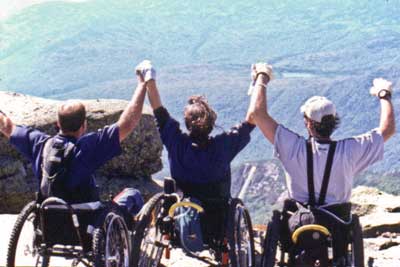Trailheads
To comply with the ABA and Section 504 of the Rehabilitation Act of 1973, ensure that each constructed feature provided at a trailhead complies with the applicable provisions of FSORAG and ABAAS. Requirements for trailhead features, such as parking spaces, toilets, water spouts, and campsites, are explained in "Applying the Forest Service Outdoor Recreation Accessibility Guidelines" of this guidebook.
Because trailheads are usually accessed by vehicle rather than only by hiking, at least one outdoor recreation access route must connect the following places at trailheads:
-
Accessible parking spaces or other arrival point
-
Starting point of the trail
-
Accessible outdoor constructed features, elements, spaces, and facilities within the trailhead
In alterations to existing trailheads, where there is a condition for an exception, the technical requirements for the outdoor recreation access route that are affected by the condition for an exception must be achieved only to the extent practicable. If elements, spaces, or outdoor constructed features are altered at trailheads but the path of travel isn't changed, an outdoor recreation access route isn't required.
Design Tip
New trail facilities must be accessible even if the trail doesn't comply with Forest Service Trail Accessibility Guidelines.
The Architectural Barriers Act of 1968 (ABA) requires that buildings comply with the applicable accessibility guidelines. This issue was clarified for Federal agencies when a complaint was filed with the U.S. Access Board against the U.S. Department of the Interior, National Park Service for installing an inaccessible toilet at 10,000 feet (3,048 meters) on Mt. Rainer. The petitioner was a paraplegic who was climbing the mountain with a sit-ski and ropes. He was not able to use the toilet that the rest of his party could use because it wasn't accessible. The U.S. Access Board found that the National Park Service was not in compliance with ABA that requires all new construction funded by Federal Executive agencies to be accessible. The National Park Service settled the complaint by replacing the toilet with an accessible model.
The Forest Service was cited by the U.S. Access Board after a complaint was filed about a pit toilet serving the trail at North Doublehead in New Hampshire. The toilet was constructed in 1972 after the 1968 passage of the ABA, but the toilet was not accessible. The Forest Service replaced the toilet with an accessible model.
It's really in the best interests of all organizations to ensure that all facilities—regardless of where they are located—are appropriate to the setting and are accessible. When accessibility is integrated into the design from the beginning, there's not much difference in cost. If the design of a facility that's already under construction must be changed to provide for accessibility, or if an inaccessible facility has to be replaced with an accessible facility at a later date, costs will be substantial.
To quote a hiker with a Northeast Passage hiking team that includes a diverse group of people (figure 139): "Hiking a trail is a challenge by choice; using a toilet is not a choice so it shouldn't be a challenge."

Figure 139—Three members of the Northeast Passage hiking team celebrate their conquest of Mount Lafayette in New Hampshire. Photo credit: Northeast Passage, Durham, NH

User Comments/Questions
Add Comment/Question